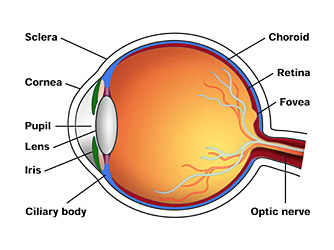MODULE: Colour perception
Step 03 of 09: Colour perception
The light in the physical world travelling as different wavelengths (constituting different colours) is eventually encountered by our eyes where some subjective processing occurs. We know that of the two photoreceptive cells used in vision, cones are more attributable to colour differentiation than rods. While the discussion regarding the mechanisms through which colour is recieved in the retina is still maturing, in a simplistic way we can identify that there are three different types of cone photoreceptors. Each type is sensitive to a different range of wavelengths of light meaning that each is either more predisposed to detecting red (long wavelength), green (medium) or blue/purple (short). This is known as the "Trichromatic theory" of colour vision and is used as a basis to explain colour-blindness.

Here is a particularly cool colour mixing applet devised by Standford
As Designers it is easy to embrace this easier-to-understand explanation of colour composition. Firstly because it corresponds well with subtractive colour mixing in artistic Colour theory of the primary colours; red, green and blue (often yellow rather than green). Then in a digital context, monitors and illuminated display media work off the RGB additive colour system where adding red, green and blue create white. We even specify colour in computing as parameters passed in terms of the amount of RGB we desire, for example; rgb(255,0,255) which would create a purple due to red(255) and blue(255) being turned on to their maximum value and no green(0) turned on.
To be more precise though, the cones are more likely to operate on an "opponent process" basis where the three types of cones work together in one area to detect which cone is activated while the others are inhibited (more on this in slide 07). It would also mean that cones are receptive of more than one wavelength and capable of detecting;
- Either white or black
- Either red or green
- Either blue or yellow
Note: This model requires significantly more processing and background elaboration to understand well,
follow this
additional reading if interested.